Randy Gallegos began producing work for Legend of the Five Rings in Imperial Edition and continued up until its first hiatus. He produced a recorded 60 pieces for cards and several more for promotional purposes. His work for the game began early before many of the designs choices you’re familiar with were finalized, such as the clan colors or mons. He shares with me in this interview his experiences working for the game then, some of his early sketches and early direction notes. We also discuss the most memorable character he illustrated and the impact he had.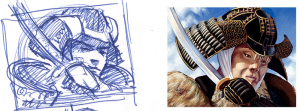
Was working for AEG your first larger project?
No, I had already done my first Magic set by that time, but it was among my first 3-4 projects probably.
Had you always wanted to do fantasy themed illustration or did you start out focusing on something different?
Yes, there was nothing else I wanted to do growing up and through college. Though even back at that time I would indulge in other genres like landscape on the side, for a career I definitely wanted to be painting in the fantasy/sci-fi realm. It’s more the case that as time has gone on I have expanded my focus these days, but fantasy art is definitely my first love, and I would love to remain involved with it going forward. The industry has changed so much though, and I no longer assume the future will be like the present, as I did when I started.
After having done work for Magic, what brought you to work for AEG and L5R? Did you work on any of their other games?
I hadn’t done much work at the time, I think my only released art was for Vampire: the Eternal Struggle (then called Jyhad), for WotC, which was my first commercial job. I had painted Ice Age, my first Magic set, but it hadn’t released yet when Art Director Matthew Wilson contacted me. I certainly didn’t know who AEG were, so I can only assume he contacted me on the basis of being in Vampire.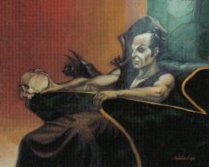
I do recall getting the initial phone call from him, however, in which he described the project and deadline and terms. I was still living with my folks (being 20). I recall him being great at explaining the world and my being excited by it, and frankly just excited to pick up a new client. When I left art school and got my first job, the whole CCG realm was brand new. It wasn’t anything I foresaw for my career, but I was entering a few years during which I would do a ton of CCG art for all the many competitors to Magic, the majority of which didn’t last very long.
So you were coming into the professional art world just as the CCG market was starting to boom? I was only around 7 at the time myself but I recall basically anything that was geek related had a card game. Due to the rise and fall of so many games did you worry that outlet of work was going to stop being there one day?
Yes, it was good timing to enter the industry; the number of available projects increased many multiples over the size of the market for fantasy illustration even a year prior, with sets having hundreds of illustrations needed each, across many games.
I knew the market was going to be a bubble, but I assumed this new form of game would probably continue on longer-term the way Role-Playing Games did before them. I just didn’t imagine that Magic would last as long as it has. More surprising perhaps is that L5R also lasted. It has to be the second longest-running CCG out there if I’m not mistaken. I played quite a number of those CCG games in those early days. Magic and L5R were my favorites, honestly. I don’t think I have my deck anymore, but I’m pretty sure I played Crab. I’m sure that had nothing to do with the fact that I illustrated the Crab stronghold in the initial release.
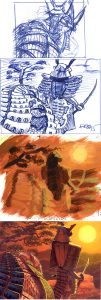 Yea the game did seem to survive a lot longer than anyone could have predicted. What were the initial assignments that you were given for L5R?
Yea the game did seem to survive a lot longer than anyone could have predicted. What were the initial assignments that you were given for L5R?
I seem to recall but am not sure that I might have received my initial assignment in that same phone call with Matt Wilson, in which he asked how many illustrations I could take. I did 11 in the initial set, which is even more than I recall. I probably did them all in about a month, which is much faster than I would ever work these days; of course as a result many of them were rushed. It was the way of the world in those days (see early Magic art). It was nevertheless a busy schedule, and I seem to recall that it wasn’t only project I had going at that time! This would have been in the late March through early May period of 1995.
So of your first few assignments you had a few clan specific cards a Crab stronghold, a Dragon personality, and the at the time unaligned but still Lion clan based Toturi. What was the direction you were given with these pieces? Did Matt have clan specific requirements for making those pieces?
The art direction was pretty loose on the first set if I recall. There were some conceptual things communicated for some cards, but that was it. The Clans were established, and Toturi was described as sort of being an important character but I don’t recall at that time how much of his backstory was in place yet. Since the worldbuilding seemed to be active and not matured yet, you get things like Mirumoto Daini’s dragon on his helmet not mirroring any clan symbol, which makes me think that the clan symbols weren’t ready yet, though of course they were by the game’s release.
So at the time of making these characters you didn’t know how much of an impact that they would have?
I did not have much idea about the potential impact of the game in general. I wasn’t going to assume that the game would make it very far, and I didn’t yet understand the overall story continuity, as this was fairly new in the CCG days and was before any other CCG I think started having cross-set story arcs with characters that persisted and matured.
This was only the 2nd non-Wizards card game I worked on–I would go on in 1995 to work on Middle Earth, Shadowfist, a couple others and even new WotC games like Netrunner. It was a busy year, and I had no idea what would hit and what wouldn’t. At the time I worked on it, only one of my projects to date had even been published (Vampire, formerly Jyhad), so I had this backlog of illustrations I’d been doing that first year that hadn’t hit market, even my first Magic set (Ice Age), and I was very interested to see what else would do well.
I will say that I hoped this one would hit more than some others simply on the basis of the differentiated visuals and fantasy-cultural background. Quite apart from anime and manga, which I’ve never been big on, I’ve always been something of a Japanophile, to the extent that I’ve studied the language for some years now (but not back then).
I was at GenCon that summer. It was my first chance to meet Matt (and a number of the other newer illustrators of the era I was working with on these games). I was chagrined to see that the test sheets Matt picked up en route had a misprint wherein my Medium Calvary image was credited to Mark Tedin! It was fixed for release, of course. It seemed like the game was well-received, and it looked great visually, too. It’s still a blast to see a set of cards you worked on simultaneously with other artists, and to see each other’s efforts done at the same time. Of course, many if not most of the artists were early Magic artists, so it was doubly interesting to see them do other styles of work, too.
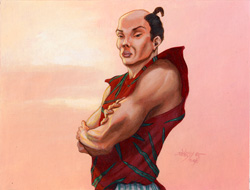 So jumping ahead a year to Anvil of Despair you’re given a handful of cards to do and one of them is a new version of Toturi. Were you given a better idea at that time of the impact this character was having on the game and it’s story?
So jumping ahead a year to Anvil of Despair you’re given a handful of cards to do and one of them is a new version of Toturi. Were you given a better idea at that time of the impact this character was having on the game and it’s story?
Yes, I have some hard-to-discern notes from that set from a phone call with Matt, where I’m learning more of his backstory and where he’s at. He’s becoming more of a leader, but I didn’t want to just show him in armor again–certainly not all warriors spent all their time in armor. He has his own clan by this point, a “small home/fort near a river” from my notes (and the illustration I did), so there would be times between official action when he would be more at ease and yet still a leader.
I’m also reminded that I did a large-scale illustration for that set that was used as an in-store promotional poster. In it, I portrayed Toturi, Mirumoto Daini and I forget the name of one of the characters popularized by Brian Snoddy. There’s a wolf crest on Toturi’s helmet there, but it was before one was actually designed in-house. It was a great big painting: 20×30″.
That would be the ronin Dairya. He was a prominent member of Toturi’s army. Did you collaborate with Snoddy when creating that piece?
No not at all, but I knew the character and liked his design quite a lot, Brian being one of the few original illustrators who really understood samurai armor design well.
Daini is a card I remember from the early days of the game. A friend pointed out how good he was for his cost and I never forgot him. You mention him being one of your favorites. What other pieces from back then stand out to you?
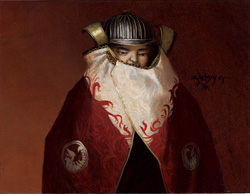 My favorites from the first sets were Daini, Toturi, and Bayushi Kyoto. Kyoto was a slightly pretentious attempt to paint a formal portrait of the character, the way you see posed photos of Samurai from the mid-1800s. He wears a form of kaji shozoku, for withstanding fires. As a saboteur, seemed like a good idea
My favorites from the first sets were Daini, Toturi, and Bayushi Kyoto. Kyoto was a slightly pretentious attempt to paint a formal portrait of the character, the way you see posed photos of Samurai from the mid-1800s. He wears a form of kaji shozoku, for withstanding fires. As a saboteur, seemed like a good idea
Moving ahead in the timeline again you were tasked to once again create a Toturi piece, but this time for his Seven Thunder version. Was this assigned to you for having done the previous versions of him or did you request it? Also was there any specific growth or aspect of the character you wanted to emphasize with this piece?
The next one I did was for Time of the Void I think? I didn’t do the Seven Thunder version from what I’m seeing. There, he was now established as his own clan so I chose him armored again, and on horseback. You’ll note that his helmet has removed the lion’s mane and teeth present in the first version; his armor in general mirrors the changes made on that poster.
That was in fact his Seven Thunder version. Before the next version you did a major story event happened involving him and he became emperor. How did you feel about this character you have continuously brought to life achieving such a rank?
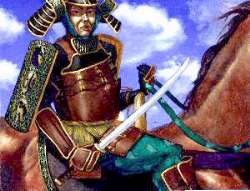 It was a bit of a surprise, but by that point I was losing touch with the game. I was no longer playing CCGs anymore, and with my career kinda going full-steam it was unfortunately becoming more just about the projects. I knew obviously that he seemed to go to the Dark Side, as it were. That was kind of a surprise, but I was losing touch with the story by then.
It was a bit of a surprise, but by that point I was losing touch with the game. I was no longer playing CCGs anymore, and with my career kinda going full-steam it was unfortunately becoming more just about the projects. I knew obviously that he seemed to go to the Dark Side, as it were. That was kind of a surprise, but I was losing touch with the story by then.
Eventually, with changes in the company that happened, the payment also dropped and it became harder to motivate myself to work as long on pieces, or to take many commissions from them. So when I was later asked to paint Toturi the First, and told the story of his sort of death and rebirth, I decided I would make that my last L5R illustration, and really give it the attention it deserved, the way I had in some of those earliest ones. I painted it larger, at 11×17″, but designed for the card crop. Finally, it and Mirumoto Daini remain my two favorites of all my L5R work; fittingly, one from the first set, one from the last I worked on.
It was only 5 years between those two paintings, and my full tenure with L5R, but it felt like longer and they were 5 very important years in my career, during which I really grew into a fully-formed adult and illustrator.
What would you say is the greatest thing you take away from your time working on the game?
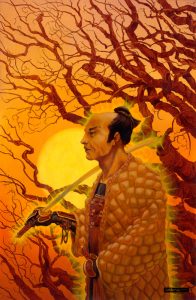 As an illustrator, your art is mostly only going to live in its primary form for a limited time. For some projects which die quickly, few people ever see it–and that’s what we’re after, getting our art out there! Sure we can highlight it ourselves, but nothing beats being part of a project that reaches people all over.
As an illustrator, your art is mostly only going to live in its primary form for a limited time. For some projects which die quickly, few people ever see it–and that’s what we’re after, getting our art out there! Sure we can highlight it ourselves, but nothing beats being part of a project that reaches people all over.
For that reason, I’m really proud of being a part of L5R, a game which has really weathered very difficult changes in the industry. It did so in large part because the fan base was so faithful, and also because they built it from the start with this compelling narrative. Oh, and it’s a good game too.
L5R started and ended for me in the first 5 years of my career, and I look back on it proudly. I developed as an artist through the game, and it was in the background of many important changes in my early adult life. Honestly, I wish it had had the budget that would have enabled me to continue working on it. It was always a breath of fresh air to shift my visual sense and work in Rokugan.
Those are some great words to end on but there’s one last question. If Fantasy Flight called you up today to create one more Toturi piece, would you?
It’s been long enough that some sort of return to Rokugan would be interesting. Of course, one of the reasons I had to stop working for L5R was fee-related, but if the fee and assignment was right, I’d love to.
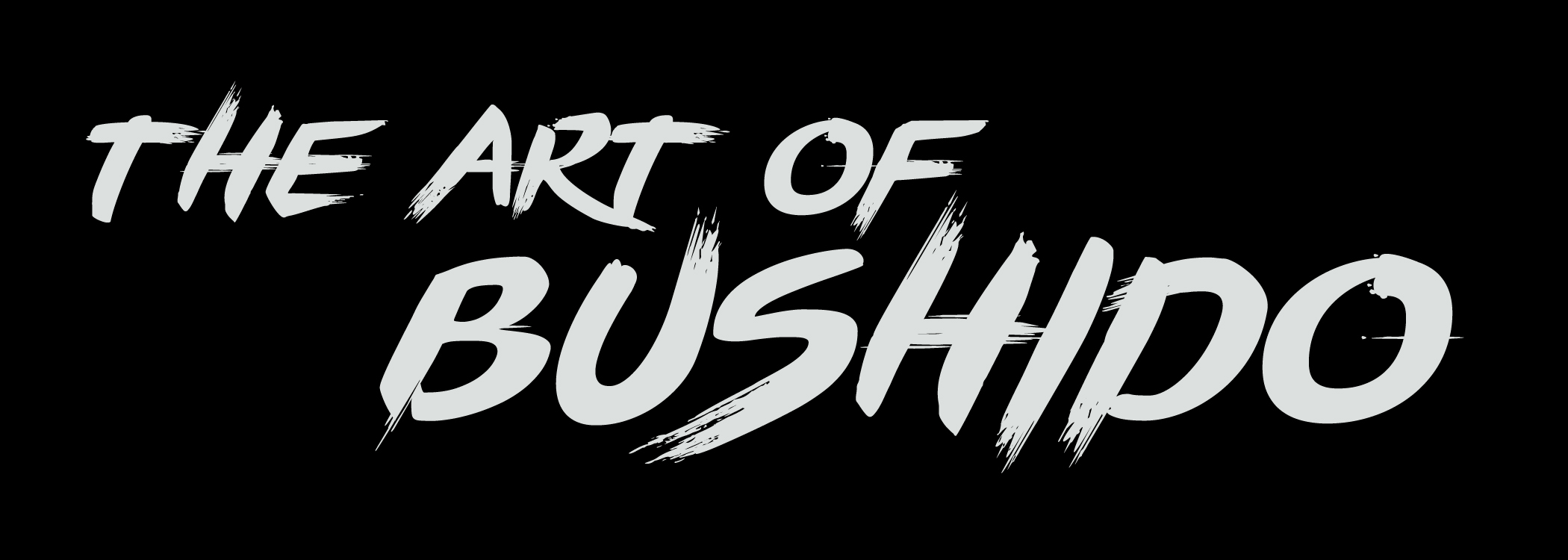
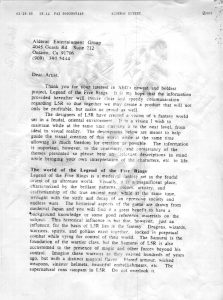
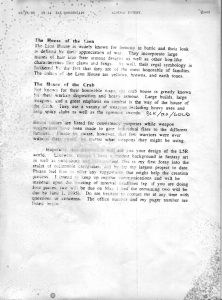
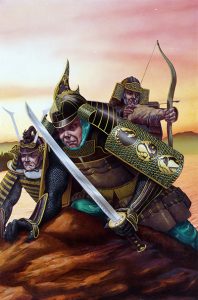
“I was chagrined to see that the test sheets Matt picked up en route had a misprint wherein my Medium Calvary image was credited to Mark Tedin! It was fixed for release, of course.”
AEG for whatever reason had some attribution issues. Deadlands: Doomtown (Which Randy also illustrated, but is correctly attributed throughout) has DOZENS of misattributions. I send a card out for signing and get ‘great art, not mine.’ I’m slowly working through and writing the wrongs (I work on a master database for Doomtown and we now have a column for ‘actual artist’. Glad Randy caught the one mentioned for L5R.